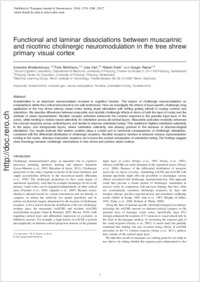Functional and laminar dissociations between muscarinic and nicotinic cholinergic neuromodulation in the tree shrew primary visual cortex
- Bhattacharyya, Anwesha Visual Cognition Laboratory, Department of Medicine, University of Fribourg, Switzerland - Fribourg Center for Cognition, University of Fribourg, Switzerland
- Bießmann, Felix Visual Cognition Laboratory, Department of Medicine, University of Fribourg, Switzerland - Machine Learning Group, Berlin Institute of Technology, Berlin, Germany
- Veit, Julia Visual Cognition Laboratory, Department of Medicine, University of Fribourg, Switzerland - Fribourg Center for Cognition, University of Fribourg, Switzerland
- Kretz, Robert Visual Cognition Laboratory, Department of Medicine, University of Fribourg, Switzerland
- Rainer, Gregor Visual Cognition Laboratory, Department of Medicine, University of Fribourg, Switzerland - Fribourg Center for Cognition, University of Fribourg, Switzerland
-
04.04.2012
Published in:
- European Journal of Neuroscience. - 2012, vol. 35, no. 8, p. 1270-1280
English
Acetylcholine is an important neuromodulator involved in cognitive function. The impact of cholinergic neuromodulation on computations within the cortical microcircuit is not well understood. Here we investigate the effects of layer-specific cholinergic drug application in the tree shrew primary visual cortex during visual stimulation with drifting grating stimuli of varying contrast and orientation. We describe differences between muscarinic and nicotinic cholinergic effects in terms of both the layer of cortex and the attribute of visual representation. Nicotinic receptor activation enhanced the contrast response in the granular input layer of the cortex, while tending to reduce neural selectivity for orientation across all cortical layers. Muscarinic activation modestly enhanced the contrast response across cortical layers, and tended to improve orientation tuning. This resulted in highest orientation selectivity in the supra- and infragranular layers, where orientation selectivity was already greatest in the absence of pharmacological stimulation. Our results indicate that laminar position plays a crucial part in functional consequences of cholinergic stimulation, consistent with the differential distribution of cholinergic receptors. Nicotinic receptors function to enhance sensory representations arriving in the cortex, whereas muscarinic receptors act to boost the cortical computation of orientation tuning. Our findings suggest close homology between cholinergic mechanisms in tree shrew and primate visual cortices.
- Faculty
- Faculté des sciences et de médecine
- Department
- Département de Médecine
- Language
-
- English
- Classification
- Biological sciences
- License
-
License undefined
- Identifiers
-
- RERO DOC 29132
- DOI 10.1111/j.1460-9568.2012.08052.x
- Persistent URL
- https://folia.unifr.ch/unifr/documents/302423
Statistics
Document views: 112
File downloads:
- pdf: 238
